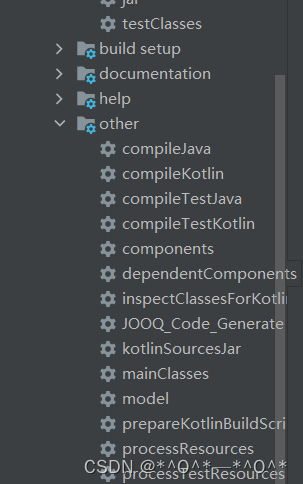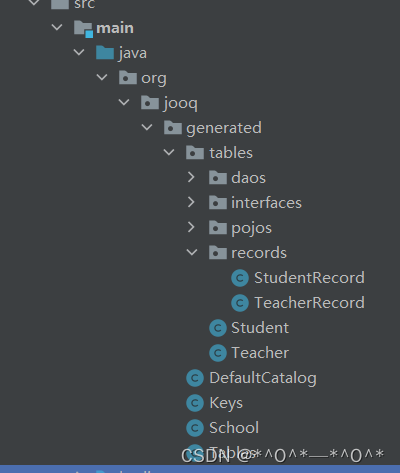jOOQ,是一个ORM框架,利用其生成的Java代码和流畅的API,可以快速构建有类型约束的安全的SQL语句
jOOQ使我们的重心可以放在业务逻辑上,而Java与SQL的基础交互部分,都可以交给jOOQ去处理。
https://jooq.diamondfsd.com/learn/section-1-how-to-start.html
gradle的配置文件(build.gradle.kts)
import org.jetbrains.kotlin.gradle.tasks.KotlinCompile
import org.jooq.codegen.GenerationTool
import org.jooq.meta.jaxb.*
plugins {
id("org.springframework.boot") version "2.6.0"
id("io.spring.dependency-management") version "1.0.11.RELEASE"
kotlin("jvm") version "1.6.0"
kotlin("plugin.spring") version "1.6.0"
}
group = "rin"
version = "0.0.1-SNAPSHOT"
java.sourceCompatibility = JavaVersion.VERSION_1_8
repositories { //repositories闭包
mavenLocal() //配置先从本地仓库寻找jar包,优先寻找上一个配置,找到不执行下面的配置
mavenCentral() //配置从中央仓库寻找
google() //第三方仓库
jcenter() //代码托管库:设置之后可以在项目中轻松引用jcenter上的开源项目
}
buildscript {
repositories {
mavenLocal()
mavenCentral()
}
dependencies {
classpath("org.jooq:jooq-codegen:3.14.15")
classpath("mysql:mysql-connector-java:8.0.27")
}
}
dependencies {
implementation("org.springframework.boot:spring-boot-starter-jooq")
implementation("org.springframework.boot:spring-boot-starter-web")
implementation("com.fasterxml.jackson.module:jackson-module-kotlin")
implementation("org.jetbrains.kotlin:kotlin-reflect")
implementation("org.jetbrains.kotlin:kotlin-stdlib-jdk8")
runtimeOnly("mysql:mysql-connector-java:8.0.27")
testImplementation("org.springframework.boot:spring-boot-starter-test")
implementation("org.jooq:jooq:3.14.15")
implementation("org.jooq:jooq-codegen:3.14.15")
implementation("org.jooq:jooq-meta:3.14.15")
implementation("com.xiaoleilu:hutool-core:3.3.2")
implementation ("org.projectlombok:lombok:1.18.24")
}
tasks.register("JOOQ_Code_Generate") {
doLast {
val config: org.jooq.meta.jaxb.Configuration = Configuration()
.withJdbc(Jdbc()
.withDriver("com.mysql.cj.jdbc.Driver")
.withUrl("jdbc:mysql://localhost:3306/school?characterEncoding=utf-8&serverTimezone=Asia/Shanghai")
.withUsername("root")
.withPassword("123456"))
.withGenerator(Generator()
.withGenerate(Generate()
.withComments(true) // 注释 √
.withCommentsOnCatalogs(true)
.withRelations(true)
.withImmutablePojos(false) // if true, cannot use 'into()' method
.withInterfaces(true)
.withDaos(true))
.withDatabase(Database()
.withName("org.jooq.meta.mysql.MySQLDatabase")
.withIncludes(".*")
.withExcludes("")
.withInputSchema("school")
)
.withTarget(org.jooq.meta.jaxb.Target()
.withPackageName("")
.withDirectory("src/main/java"))
)
GenerationTool.generate(config)
}
}
tasks.withType<KotlinCompile> {
kotlinOptions {
freeCompilerArgs = listOf("-Xjsr305=strict")
jvmTarget = "1.8"
}
}
tasks.withType<Test> {
useJUnitPlatform()
}
上面的需要的依赖,下面的tasks.register(“JOOQ_Code_Generate”) 是jooq根据表自动生成Java代码的文件,在kts文件中运行后,会出现如下图这样的,然后点击JOOQ_Code_Generate就会自动生成代码


如图就是自动生成代码之后的目录结构
application.yml文件
server:
port: 8080
spring:
datasource:
driver-class-name: com.mysql.cj.jdbc.Driver
url: jdbc:mysql://localhost:3306/school?serverTimezone=GMT%2B8
username: root
password: 123456
这里只需要配置最简单的数据库连接就可以了
controller
package com.demo.controller
import com.demo.service.StudentService
import com.demo.util.R
import org.jooq.generated.tables.pojos.Student
import org.springframework.beans.factory.annotation.Autowired
import org.springframework.web.bind.annotation.*
@ResponseBody
@RestController
@RequestMapping("/student")
class StudentController {
@Autowired
lateinit var studentService: StudentService
@GetMapping
fun getOne(id:Int): R<*> {
return studentService.getOne(id)
}
@DeleteMapping
fun deleteOne(@RequestBody student: Student):R<*>{
return studentService.deleteOne(student)
}
@PostMapping
fun insertOne(@RequestBody student: Student):R<*>{
return studentService.insertOne(student)
}
@PutMapping
fun updateOne(@RequestBody student: Student):R<*> {
return studentService.updateOne(student)
}
@GetMapping("/all")
fun getAll():R<*>{
return studentService.getAll()
}
}
自封装的返回类
package com.demo.util;
import java.io.Serializable
/**
* 全局统一返回结果类
*/
class R<T> : Serializable {
private var code = 0
private var msg: String? = null
private var data: T? = null
override fun toString(): String {
val var10000 = getCode()
return "R(code=" + var10000 + ", msg=" + getMsg() + ", data=" + getData() + ")"
}
constructor() {}
constructor(code: Int, msg: String?, data: T) {
this.code = code
this.msg = msg
this.data = data
}
fun getCode(): Int {
return this.code
}
fun setCode(code: Int): R<T> {
this.code = code
return this
}
fun getMsg(): String? {
return msg
}
fun setMsg(msg: String?): R<T> {
this.msg = msg
return this
}
fun getData(): T? {
return data
}
fun setData(data: T): R<T> {
this.data = data
return this
}
companion object {
private const val serialVersionUID = 1L
fun <T> ok(data: T): R<T?> {
return restResult(data, 200, null as String?)
}
fun <T> ok(data: T, msg: String?): R<T?> {
return restResult(data, 200, msg)
}
fun <T> failed(data: T): R<T?> {
return restResult(data, 400, null as String?)
}
fun <T> failed(data: T, msg: String?): R<T?> {
return restResult(data, 400, msg)
}
private fun <T> restResult(data: T, code: Int, msg: String?): R<T?> {
val apiResult: R<T?> = R<T?>()
apiResult.setCode(code)
apiResult.setData(data)
apiResult.setMsg(msg)
return apiResult
}
}
}
dao层,简单的CRUD操作
import com.demo.service.StudentService
import com.demo.util.R
import org.jooq.DSLContext
import org.jooq.generated.Tables.STUDENT
import org.jooq.generated.tables.pojos.Student
import org.springframework.beans.factory.annotation.Autowired
import org.springframework.stereotype.Service
@Service
class StudentServiceImpl : StudentService {
@Autowired
lateinit var dslContext: DSLContext
override fun getOne(id: Int): R<*> {
println("开始查询")
val student = dslContext!!
.select()
.from(STUDENT)
.where(STUDENT.ID.eq(id))
.fetchOne()?.into(Student::class.java)
return R.ok(student,"成功")
}
override fun deleteOne(student: Student): R<*> {
println("开始删除")
var line = dslContext
.delete(STUDENT)
.where(STUDENT.ID.eq(student.id))
.execute()
return R.ok(line,"删除成功")
}
override fun insertOne(student: Student): R<*> {
println("开始添加")
var line = dslContext
.insertInto(STUDENT)
.set(STUDENT.ID,student.id)
.set(STUDENT.NAME,student.name)
.set(STUDENT.AGE,student.age)
.execute()
return R.ok(line,"插入成功")
}
override fun updateOne(student: Student): R<*> {
println("开始更新")
var line = dslContext
.update(STUDENT)
.set(STUDENT.NAME,student.name)
.set(STUDENT.AGE,student.age)
.where(STUDENT.ID.eq(student.id))
.execute()
return R.ok(line,"更新成功")
}
override fun getAll(): R<*> {
println("查询所有")
val studentMap: Map<Int, Student> = dslContext.select().from(STUDENT)
.fetchMap(STUDENT.ID, Student::class.java)
return R.ok(studentMap,"返回所有")
}
}





















 6969
6969











 被折叠的 条评论
为什么被折叠?
被折叠的 条评论
为什么被折叠?








